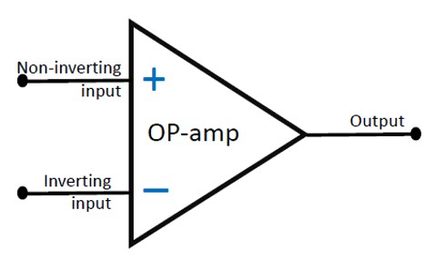Op-Amp Gain Calculator
Use Omni's op-amp gain calculator to determine the voltage gain of an operational amplifier. You can use this op-amp calculator to find out the voltage gain of an inverting op-amp as well as a non-inverting op-amp. If you want to know what an op-amp is or how to calculate the gain of an op-amp, read on. You will also find out more about what op-amps are used for and the characteristic of an ideal op-amp.
What is an op-amp (operational amplifier)?
Op-amps or operational amplifiers are electronic devices that amplify an electric signal. They are the basic building blocks of every analog electronic circuit. Op-amps perform a range of mathematical operations in analog circuits, for example, addition, integration, differentiation, comparison, etc. In addition, we also use them extensively in signal filtering and conditioning.
Gain of an op-amp

A typical op-amp (see figure 1) is basically a device with two input terminals and one output terminal. The input terminal with a negative () sign is called the inverting terminal. The input terminal with a positive () sign is called a non-inverting terminal. Both input terminals have very high electrical impedance. The third terminal is the output terminal from which we receive the output voltage or current signal. The impedance of the output terminal is almost zero.
🙋 The concept of impedance is quite important in electronics! You can see some of the examples in the cable Impedance calculator and the impedance matching calculator.
An op-amp basically amplifies the difference between the two input signals, and . The gain of a linear operational amplifier is the ratio of the output voltage to the input voltage:
where:
Can you see the similarity to the line regulation formula in the voltage regulation calculator?
Types of op-amp configuration
In op-amp circuits, we usually implement a feedback mechanism by using some external components like resistors or capacitors. Thus, the operation of an op-amp depends on the type of feedback mechanism (whether positive or negative) and the feedback component employed.
To implement negative feedback, we take a portion of the output signal and feed it back to the inverting input terminal through an external feedback resistor. This feedback connection forces the differential input voltage of the op-amp to become zero, i.e., .
Two basic operational amplifier circuit configurations are:
- Inverting op-amp: Figure 2 shows a circuit diagram of an inverting operational amplifier. In inverting configuration, we connect the input signal to the inverting terminal through resistance and ground the non-inverting terminal. The feedback resistance feeds part of the amplified output signal back to the input. The voltage gain of an inverting op-amp is:
The negative sign means that the output is 180° out of phase with the input.
- Non-inverting op-amp: Figure 3 shows a circuit diagram for a non-inverting operational amplifier. Here, we apply the input signal directly to the non-inverting terminal. To apply negative feedback, we connect the resistances and to the inverting terminal. The voltage gain of a non-inverting op-amp is:
In non-inverting op-amps, the input and output are in the same phase.
How to find the gain of an op-amp?
Let us see an example of how to calculate the voltage gain using the op-amp gain calculator. We will consider an inverting op-amp with input resistance 1 kΩ and feedback resistance of 10 kΩ.
- Choose the type of op-amp, e.g., inverting, from the drop-down menu.
- Enter the values of input resistance (1 kΩ) and feedback resistance (10 kΩ).
- The op-amp calculator will display the voltage gain of the op-amp, e.g., 10.
- If you select non-inverting op-amp, the calculator will show 11.
What are the characteristics of an ideal op-amp?
The characteristic of an ideal op-amp are:
- Infinite input impedance;
- Zero output impedance;
- Infinite voltage gain; and
- Infinite bandwidth.
What are op-amps used for?
Op-amps are mostly used as signal amplifiers in electronic circuits. Some common applications/use of op-amps are:
- To perform mathematical operations like addition, integration, differentiation, etc.
- In signal conditioning, for example, as a filter, rectifier, etc.
- As a current to voltage (or voltage to current) converter.
What is thermal drift in op-amp?
Thermal drift is the change in the normal operation of an op-amp due to a change in the external temperature. The gain, impedances (input and output), frequency response, and voltages of the op-amp change with temperature.
Operational amplifiers are electronic devices made using semiconductor components (e.g., transistors). As the properties of semiconductors strongly depend on temperature, any change in the external ambient temperature also influences the operational behavior of devices manufactured using them.
Why is an op-amp is called a differential amplifier?
An op-amp amplifies the difference of the two input voltage signals, hence the name differential amplifier.